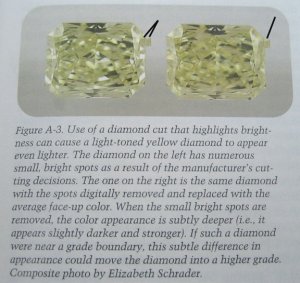jasontb
Shiny_Rock
- Joined
- Feb 10, 2006
- Messages
- 226
I should have said what I meant beacuase it seems nobody understood what I meant:
I don't know if diamonds should be color graded table up or down. I don't know enough to comment on that.
Now maybe I misunderstood, but I thought strmrdr was saying that maybe diamonds should be color graded by what color they 'look like' not by what color they 'are'. Such as: Evenly colored rough is split in half and two diamonds are cut. One is cut well and one is cut poorly. One gets a better color grade because it looks whiter face up. That seems wrong to me. Just tell me what color it is and I'll figure the rest out.
It reminds me of when AMD started marketing their processors with 'Pentium Equivalent' speeds. Don't call it an 1200 because it's as fast as a Pentium 1200-Mhz. Be honest and tell me it's a 800-Mhz processor. I am smart enought to understand that there's more to it than just the clock speed. Or how some (crummy) digital cameras tell you they have 3 million equivalent pixels. If it's a 1 megapixel camera with software that gives me an interpolated 3 million pixel image - I'd like to know that.
I guess the jist of my comment is that any color grading should be independant of other factors. And I though strm was advocating the posibility of inclucing other factors into color grading.
I don't know if diamonds should be color graded table up or down. I don't know enough to comment on that.
Now maybe I misunderstood, but I thought strmrdr was saying that maybe diamonds should be color graded by what color they 'look like' not by what color they 'are'. Such as: Evenly colored rough is split in half and two diamonds are cut. One is cut well and one is cut poorly. One gets a better color grade because it looks whiter face up. That seems wrong to me. Just tell me what color it is and I'll figure the rest out.
It reminds me of when AMD started marketing their processors with 'Pentium Equivalent' speeds. Don't call it an 1200 because it's as fast as a Pentium 1200-Mhz. Be honest and tell me it's a 800-Mhz processor. I am smart enought to understand that there's more to it than just the clock speed. Or how some (crummy) digital cameras tell you they have 3 million equivalent pixels. If it's a 1 megapixel camera with software that gives me an interpolated 3 million pixel image - I'd like to know that.
I guess the jist of my comment is that any color grading should be independant of other factors. And I though strm was advocating the posibility of inclucing other factors into color grading.










300x240.png)